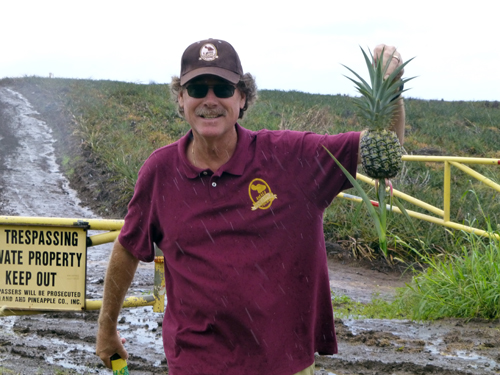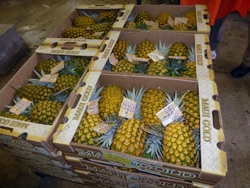
San Diego Jewish World editor Donald H. Harrison has returned to San Diego from a round-trip cruise to Hawaii. This is the seventh article in a series about that trip.
By Donald H. Harrison
HALIIMAILE, Maui, Hawaii — This rural area of Maui is where they grow and pack Maui Gold Pineapple, so perhaps it is not surprising that local residents have plenty of suggestions about how to raise, select and consume the tasty fruit.
No doubt I could have collected more pineapple lore during my visit here, but there were only a few hours available to explore the pineapple fields and packing house before Nancy and I had to take a 45-minute van ride back to Lahaina to catch a tender to our Holland America Line cruise ship, MS Zaandam.
Nevertheless, in the time allotted, we heard some valuable tips about pineapples, among them, that it’s not the color that you want to look at when selecting a pineapple from the grocery store; you want to listen to the sound. Many people are familiar with thumping a watermelon. Well, according to guide Steve Potter, you should do something similar with a pineapple — only very carefully. The 150 raised fruitlets on a mature pineapple can be sharp and bruise your knuckles. So it’s best to use your index finger to poke the pineapple between the fruitlets. The best pineapples, according to Potter, are those that produce a hollow sound.
En route to the plantation, our unidentified bus driver told passengers that pineapple juice, especially when mixed with papaya juice, makes for an excellent meat tenderizer. He said his family mixes the two fruit juices, brushes and glazes the mixture on any meat, wraps the meat in tin foil or Saran Wrap, and then stores the meat in a refrigerator for two days before cooking it. It will be “tender, tender,” he assured us.
Potter, Maui Gold Pineapple’s official guide, told us that “pineapples help with bad backs and joints,” adding that pineapples have “three times as much Vitamin C as an orange” as well as manganese and bromelain– “the things that help with bad backs, and joints, and it helps with wrinkles, so it is an all purpose fruit.”
If you think about it, the same properties that make pineapple juice a good meat tenderizer also could help reduce swelling in human tissues, so while I can’t vouch for the claims, at least I can say that they are consistent.
We learned that the crowns of pineapples can be twisted off the fruit to provide a seed source for a new plant. In Hawaii, they prefer to clone pineapples to having them pollinated by hummingbirds, because the birds may bore into the fruit. State law bans hummingbirds from Hawaii, Potter said.
“A lot of people think a pineapple grows on a tree, or a bush, or in the ground like a potato,” said Potter. “But it actually grows on a stalk and it takes 18 to 24 months to grow a pineapple.”
He said that if one wanted to go to the trouble, one could grow a pineapple in one’s home. In fact, he said, with a twinkle in his eye, “a guy from Minnesota did it. He had a five-gallon container on wheels which he wheeled around the house, to keep it in sunlight. He gave it enough water, and enough nutrients, and he was able to grow a pineapple. His wife called it ‘that damn pineapple!'”
It’s much easier to grow pineapples within a zone that reaches 25 degrees on either side of the equator. The latitude of Minneapolis is 44.98 degrees; San Diego’s is 32.72.
“Pineapples need two feet of well-drained soil that is rich in nutrients, which in Hawaii is the volcanic soil,” Potter informed us. “It needs a daytime temperature between 70 and 90 degrees which we have in Hawaii thanks to the trade winds, and it can’t get below 50 degrees. The last ingredient is abundant sunshine. So, everything the pineapple needs is right here in Hawaii.” While this may be so, pineapples are not an indigenous plant; they originated in Brazil.
After the pineapple is picked from its stalk, a second pineapple will grow from the same plant. It will be smaller than the first, and, according to Potter, this process may be continued indefinitely with each generation of fruit smaller and smaller. Maui Gold Pineapple picks the same stalk only twice. Remove the skin from a first-generation pineapple and the fruit will fill a 24-ounce can, whereas the fruit of the second generation pineapple will fill a 16-ounce can. If the pineapple were third generation, it would fill an 8-ounce can, he said.
Maui Gold Pineapple has a portable testing station in the fields. It can bore into a pineapple and take a sample of its juice, measuring for acid and sugar. The ideal mixture is 15 percent acid, 85 percent sugar. The fruit is tested again at the packing shed; if it varies too greatly from the 15-85 ratio, the fruit will be rejected.
Once delivered from the field to the packing shed, the pineapples are placed onto a conveyor belt, which takes them through washing and waxing. Potter expresses pride in both of these operations. As the pineapples are dipped in water, “if any of them start to sink, it is rejected because it either has a hole in it or it is overly ripe and therefore too dense,” he said.
“Being in the water causes them to change color. In the field they are mostly green, but once they are picked and washed they will all start to turn yellow immediately.” Potter said other companies may put bleach in the water in order to kill off bacteria, but that makes the water unusable later. He said Maui Gold Pineapple instead “puts ozone into the water.”
The ozone “will kill the bacteria, but the water is reusable,” Potter said. As a result, the company “can recycle those 25,000 gallons back into the reservoir.”
As the pineapples float along, they are subjected to a high-pressure rinse, and then to waxing. “The reason they spray it with wax is that it seals in the carbon dioxide so it will last longer, and it also gives the pineapple a nice little sheen.” Other companies use petroleum-based wax, he said, but Maui Pineapple Gold uses a wax that is vegetable based and “more ecologically friendly,” according to Potter.

As the pineapples are taken off the conveyer belts, their color is taken into account. Those that are mostly green will have a longer shelf life, and therefore will survive shipping to the West Coast of the American mainland. The others that are more yellow–which is about 80 percent of what is packed–are sold throughout the Hawaiian Islands. Those that have turned completely gold are not packed at all; rather they are converted into pineapple slices and spears for immediate sale at stands around the islands.
Whatever their color, pineapples are packed with five large pineapples to a crate, or six medium pineapples, or seven small. Costco, which prefers to sell the pineapples by the fruit, purchases them in crates of seven, whereas Safeway, which sells them by the pound, typically purchases crates of five, Potter said.
Maui Gold Pineapple is a relatively new company that was started after Maui Pineapple Company went out of business, unable to compete with the giant Dole corporation. Dole once had operations in Hawaii but moved them to Costa Rica, Thailand and the Philippines, where in all cases labor is much less expensive.
Because Maui Gold Pineapple typically is shipped over a shorter distance, the pineapples remain on the stalk longer, and therefore have — in Potter’s opinion — a better taste.
Potter ventured into a pineapple field and came back with a plant still on the stalk. Using his machete, he deftly trimmed off the skin, and then, while holding the stalk with one hand, he used his other hand to cut into the pineapple with the machete. Each time he withdrew the machete from the pineapple, it was with a nice juicy slice. “Eat as many as you want,” he invited all of us.
We were all happy to do so.
While no one in our group suddenly threw down his cane, danced the jig, and exclaimed, “My back! My back! At last I have no pain in my back!” quite a few members of our group expressed appreciation for the pineapple’s fresh-picked taste and requested second and even third slices.
*
Harrison is editor of San Diego Jewish World. He may be contacted at donald.harrison@sdjewishworld.com
Pingback: Haliimaile Peace Of Maui | vacation - vacation packages